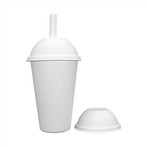Fraunhofer in Germany develops bicycle helmet made entirely of PLA
The product design of bicycle helmets usually puts functionality first. However, until now, this design has come at the expense of circularity and leaves a considerable ecological footprint - especially when the helmets are made of mass-produced petroleum-based plastics: the helmet shell is made of polycarbonate (PC), the foam core is made of polystyrene foam (EPS), the additional parts are usually made of polypropylene (PP), and the straps are made of nylon (PA). In most cases, this structure does not allow the materials to be recycled at the end of the product life cycle, both technically and economically. Therefore, the helmets are usually incinerated after three to five years of use.
Recently, researchers at the Fraunhofer Institute for Chemical Technology (Fraunhofer ICT) in Germany have developed an alternative that uses only a single material for all components. Since they wanted to completely avoid the use of petroleum, a bio-based and recyclable material was chosen - polylactic acid (PLA). With its technical properties and competitive price, PLA is already the most important bioplastic today, with a footprint eight times smaller than previously used materials.
The bicycle helmet is an ideal demonstrator for new materials and design concepts, as it must guarantee high functionality, especially high energy absorption, and low weight. Wearing comfort, price and appearance are also key to market success. As a market-oriented project, Fraunhofer ICT worked with several industrial companies (Comfil ApS, Elas A/S, WSVK, Polyola SAS) to develop particle foam, thermoformed films, fibers and composite materials made entirely of polylactic acid over 18 months, making the end product recyclable. Thanks to the extensive cooperation, the polylactic acid helmet can be mass-produced using the same processes as conventional petroleum-based bicycle helmets. This lays the foundation for the new helmet to compete on the market.

The material's resistance to common environmental influences during use has been positively verified, and external tests aimed at proving the helmet's usability are still underway. A life cycle analysis (LCA) will also quantify the carbon footprint of a mono-material bicycle helmet over the entire production, use and end of life compared to a helmet made of petroleum-based materials.









